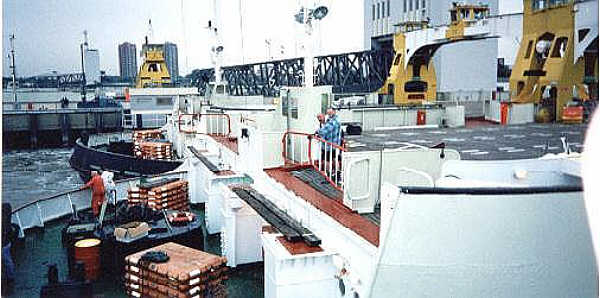


| When a ferry breaks
down which is a rare occurrence, it can really mess up the service.
In the picture above two boats are on the repair grid. While the third is in service at the terminal. |
|
Traffic The Woolwich Ferry carried slightly over 1 million vehicles in 1996/97 and about 2.5 million passengers. There are imbalances between the North and South Terminals in traffic flow. The southbound flow averages 1,968 vehicles/day and the northbound 1,554 vehicles/day. At the South Terminal, the flow of cars shows marked a.m. (06:00 - 08:00) and p.m. (17:00 - 19:00) peaks but goods traffic is steady until 15:00. In contrast, for the North Terminal, there is a slight a.m. peak for cars but a large p.m. peak and variable goods traffic dropping after 16:00. Cars and LGV traffic is greater from the North Terminal throughout he day, while for HGVs traffic is greater from the South Terminal after 09:00. There may be more HGVs travelling from the South Terminal because, or partly because, of height restrictions on the northbound Blackwall Tunnel but this has not been checked by survey and cannot be confirmed. The average transit time in the most favourable conditions with little or no queueing would be 11 minutes with two vessels operating and 15 minutes with one vessel. Our survey indicated that. for cars the average transit time was 19 minutes during weekdays except during rush hours when it rises to 25 to 35 minutes. For goods vehicles, the average transit time was 51 minutes (South Terminal) and 28 minutes (North Terminal) during weekdays. On the southside, it is common to find queues of goods vehicles right through the day. Demand is close to capacity much of the time, so the service can he quickly overwhelmed. Thus, with one vessel working and also when an accident occurred in the Blackwall Tunnel. transit times can, rise to one hour for cars and two hours for goods vehicles. Excerpt
from Government Office for London Report 1997
|